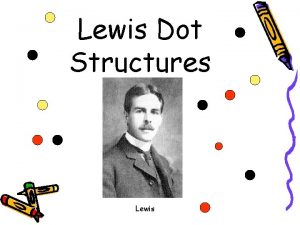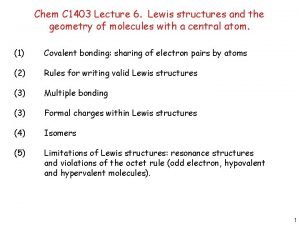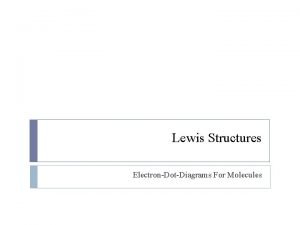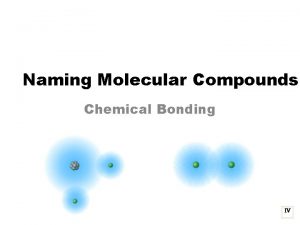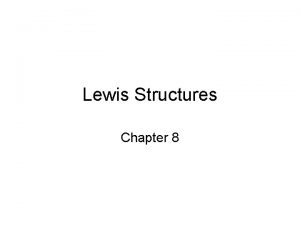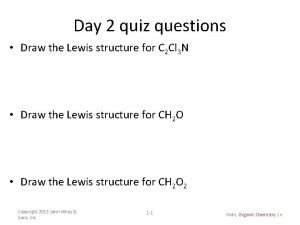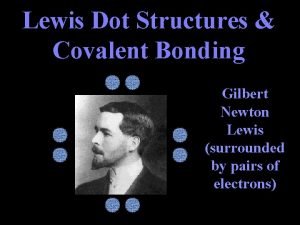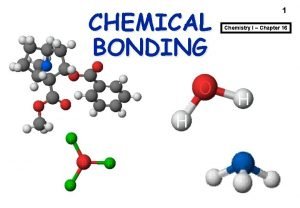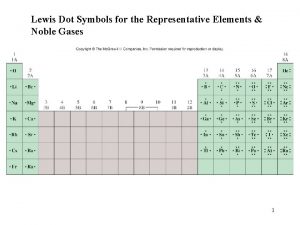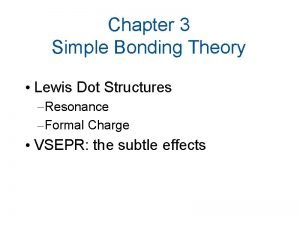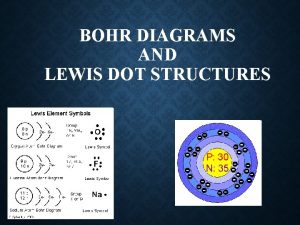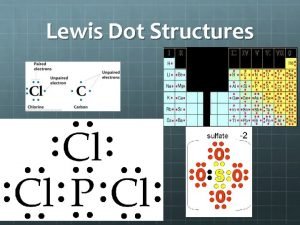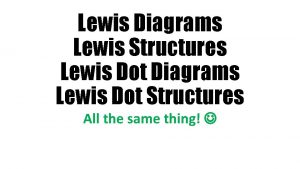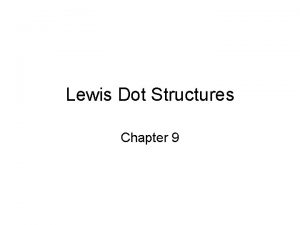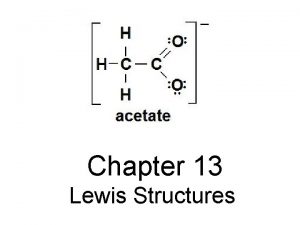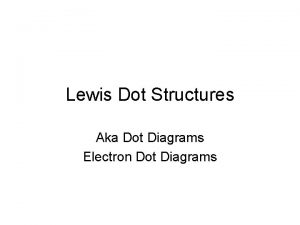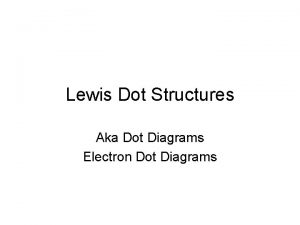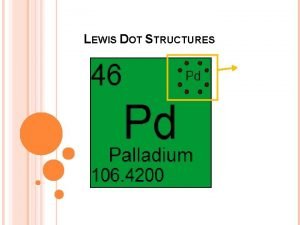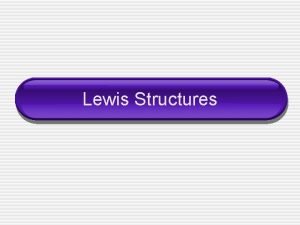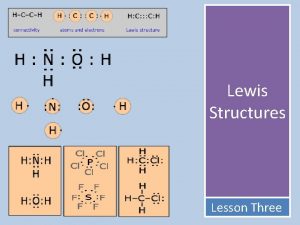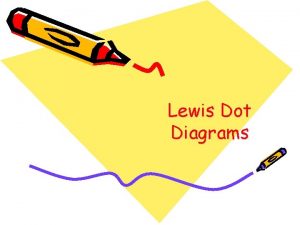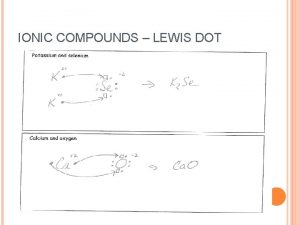Lewis Dot Structures EQ How are Lewis Dot


























- Slides: 26

Lewis Dot Structures EQ: How are Lewis Dot Structures drawn to model the sharing or transfer of electrons in chemical compounds?

What will you be doing? ? ? � Draw a Lewis Dot Diagram for an element given its location on the periodic table. � Show cations and anions are formed during ionic bonding using Lewis Dot Diagrams for the elements involved.

Review � What � How � What is a valence electron? many valence electrons does sulfur have? is the octet rule? does sulfur need to do in order to achieve the octet rule?

Review � For the following: ◦ Determine the bond type ◦ State whether it’s an electrolyte or nonelectrolyte 1. Sodium and oxygen 2. Sulfur and fluorine 3. Carbon and nitrogen

Ionic vs. Covalent � What types of elements make up an ionic bond? � What types of elements make up a covalent bond?

Lewis Dot Structures � Model used to represent valence electrons in elements and compounds � Used to predict molecular shape � MUST FOLLOW HUND’S RULE � Define rule): Hund’s Rule (seats on a school bus

For elements… � Determine # valence electrons � Place electrons around symbol following Hund’s rule � BE NEAT!

Example � Sulfur � How many valence electrons?

You try! � Carbon � Boron � Argon

For Ions � Cations: lose electrons, positively charged � Anions: gain electrons, negatively charged � Write structure in brackets with superscript � Include appropriate number of valence e� Example: Al+3 O-2

Examples Al+3 O-2

You try! Ca 2+ Cl-

For Ionic Compounds � What type of elements? � Draw as ions in brackets � Place Opposite charges together to show ionic bond Example: Na. Cl Mg. Br 2

You try! Ca. O KI

PRACTICE! � COMPLETE PAGE THE WORKSHEET ON THE NEXT

Review � On the white boards…. � What is an ionic bond? � Give me 2 elements that would form an ionic bond

Review � What � Give is a covalent bond? me two elements that would form a covalent bond

REVIEW � What difference in electronegativity would make a bond polar covalent?

REVIEW � Draw � Is the Lewis Dot structure for Na. O 2 this compound an electrolyte or nonelectrolyte?

For covalent Bond Type Single Double triple # electron pairs Lewis notation

Steps for drawing Covalent Lewis Dot Structure � 1. add up the total # of valence electrons � 2. Put central atom in the middle, with other atoms connected with a single bond ◦ Remember, each line represents 2 electrons � 3. add remaining electrons to outer atoms, then central atoms. a. If not enough electrons, form double/triple bonds. b. If electrons are left over, place as lone pairs on central atom.

Examples Ex CCl 4 H 2 O O 2 (NO 3)- #of Valence e- Lewis Dot Structure

Resonance structures � Draw the Lewis Dot Diagram for the carbonate ion (CO 3)-2

Resonance Structures � Occurs when a double bond or triple bond can occur in multiple places � Draw all possible structures with a double headed arrow connecting them � In class, represent with an “R”

Incomplete octet � Due to not enough electrons (very rare) � Hydrogen can only have 2 � Boron can have 6 � Beryllium can have 4 only � BH 3 (6 e-)

Exceptions to the Octect Rule � Expanded octets ◦ Due to d-orbital presence ◦ Example: Sulfur and Phosphorus can have up to 12 valence electrons surrounding it. SF 6 (48 e-) Note: I will tell you if it is an exception to the rule
 Antigentest åre
Antigentest åre Electron dot diagram
Electron dot diagram Bohr rutherford diagram vs lewis dot diagram
Bohr rutherford diagram vs lewis dot diagram 192 dot 168 dot 1 dot 1
192 dot 168 dot 1 dot 1 Homologous
Homologous Lewis structures cannot
Lewis structures cannot Lewis dot structure cl
Lewis dot structure cl Formal charge of hcn
Formal charge of hcn Vsepr model vs lewis structure
Vsepr model vs lewis structure Rules for drawing lewis structures
Rules for drawing lewis structures What is the molecular formula for heptachlorine hexoxide?
What is the molecular formula for heptachlorine hexoxide? No+ lewis structure
No+ lewis structure Lewis structures represent the
Lewis structures represent the Carbon monoxide lewis structure
Carbon monoxide lewis structure Important lewis structures
Important lewis structures Assignment 9 solving inequalities
Assignment 9 solving inequalities Java vs dot net
Java vs dot net Acetone lewis structure
Acetone lewis structure Lewis structure quiz
Lewis structure quiz Why school should be shorter
Why school should be shorter Lewis dot structure of kf
Lewis dot structure of kf Hnhh polar or nonpolar
Hnhh polar or nonpolar Structure and bonding in organic chemistry
Structure and bonding in organic chemistry Dot
Dot What are representative elements
What are representative elements Simple bonding theory
Simple bonding theory Review bohr and lewis dot diagrams
Review bohr and lewis dot diagrams

